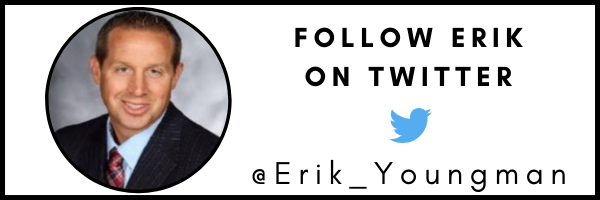TL;DR:
- Moving out of your comfort zone, growth, and change is a process.
- This blog focuses on how different frameworks connect to help us understand our controllables and the process of change and growth.
The goal of this blog is to simplify the framework of moving out of your comfort zone by connecting to other frameworks that can enhance focus on different variables that people can control during different phases of a process. An impactful lens is to focus on what you can control. However, rather than this general focus, let’s unpack how this looks for different phases of a journey to better understand how and when to focus on what can be controlled.
This blog combines and synthesizes three frameworks educators and leaders discuss and proposes a new framework. The three frameworks are a comfort zone, focusing on what can be controlled compared to what can’t be controlled, and a revised Bloom’s Taxonomy. Additionally, there are four levers that can enhance the impact of these frameworks. These levers are starting, seeking support, self-care, and a strategy toolbox.
A New Overarching Framework
Noted below is a new overarching framework called, “Move Out of Your Comfort Zone by Focusing on What You Can Control.” The framework specifies skills and mindsets that can be used at different times when you are taking risks to move outside of your comfort zone. Skills and mindsets align with the table and images below. Each zone can be understood in a standard formula based on what can be controlled, what can’t be controlled, the Revised Bloom’s Taxonomy, and potential levers to enhance impact.
Additional information is readily available about these three frameworks. Therefore, this blog will focus on the application of these frameworks rather than summarizing them. The first part of the blog will discuss each of these frameworks. The second part of the blog applies and connects all of these frameworks together into the new framework. Tables and images throughout the blog can be reviewed in isolation or while reading additional contexts specified in the blog.
Processes and Journeys
Words written on the mountain image below specify processes and journeys. Processes and journeys happen daily, weekly, monthly, and throughout our lives. These processes and journeys are typically more complex and difficult than expected. Common encounters that require patience, problem-solving, and resilience include ambiguity, challenges, experiences, rejections, mistakes, misunderstandings, destinations, opportunities, passion, and potential.
Embrace the present time, interactions, moments, journeys, progress, and the learning process. Learn information to make informed decisions, appreciate new perspectives, and develop habits and routines. Click To TweetFocusing on What Can Be Controlled
Focusing on what can be controlled frameworks are typically explained with a circle diagram. One circle for what a person can control. And a different circle for variables people don’t typically have control over. The “Move Out of Your Comfort Zone by Focusing on What You Can Control” framework explains, during different phases, both what a person can control and what people don’t typically have control over.
For example, a person can control thinking, focus, actions, self-care, resilience, innovation, and purpose. However, connecting what a person can control with different phases of processes or journeys enhances application and impact.
Images in this blog will show parts of the guiding image as each zone is discussed. The final image shows the complete image. Noted below are the first two guiding images that include information about what a person can control and different processes and journeys.
Image one shows building blocks that people experience, learn from, and become stronger because of as they progress on journeys. Image two shows a more simplified version. Both images can be viewed through the lens of one area of focus that can be controlled in the journey.
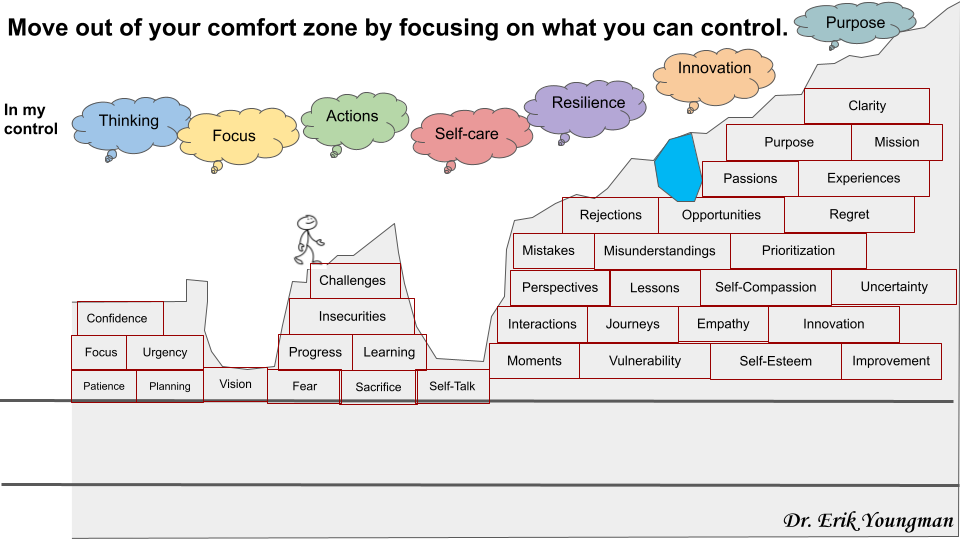
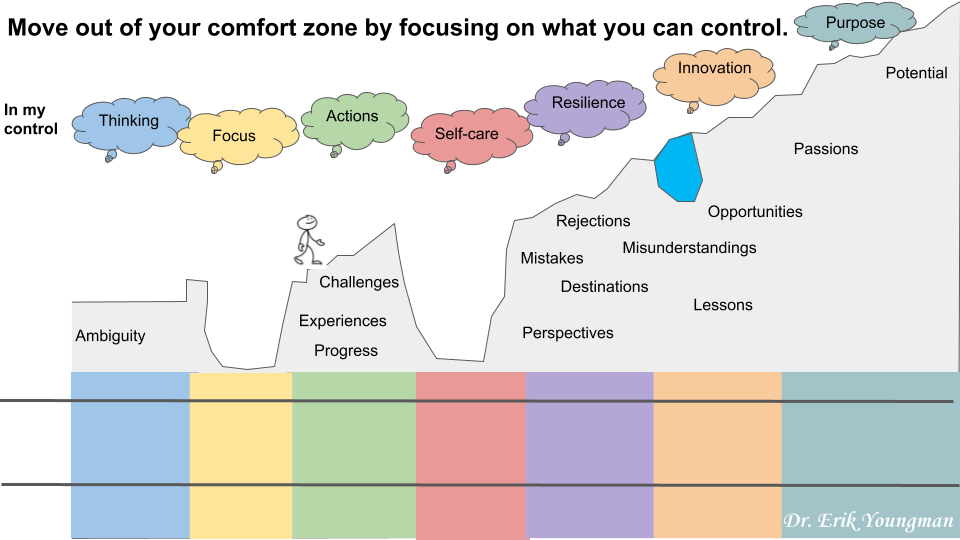
The Comfort Zone
The comfort zone framework is also typically explained with circle diagrams. Circles for comfort zones focus on different zones or topics but typically include a comfort zone. This blog will bring those circles to life by organizing relationships in charts and a diagram. Zones can be analyzed independently and collectively.
People can remain in a zone or transition between zones during an activity or during different points in time. The duration within zones may also vary, but the process includes similar components. My framework includes a comfort zone, fear zone, learning zone, stress zone, growth zone, change zone, and teaching zone.
Move Out of Your Comfort Zone by Focusing on What You Can Control Framework
The table below organizes other frameworks so comfort zone variables can be organized by what a person is in control of, what is out of their control, Bloom’s Taxonomy, processes and journeys, as well as enhancing levers. The levers of seeking help, self-care, and the strategies from a toolbox can happen at different phases of the process. However, these levers are listed under specific phases where these levers could have the greatest impact.
| Comfort
Zone |
Fear
Zone |
Learning Zone | Stress Zone | Growth Zone | Change Zone | Teaching Zone | |
| In my control | Thinking | Focus | Actions | Self-care | Resilience | Innovation | Purpose |
| Out of my control | Other people’s words | Other people’s judgments, opinions, and reactions | Thoughts of Others | The past, future, and outcomes | Progress of Others | Other people’s actions | Other people’s knowledge |
| Bloom’s Taxonomy | Understand | Explain | Apply | Adapt | Analyze | Evaluate | Create |
| Processes and journeys | Ambiguity | Challenges, experiences, and progress | Rejections, mistakes, destinations, misunderstandings, perspectives, lessons, and opportunities | Passions and potential | |||
| Levers | Start | Seek help | Self-care | Strategy Toolbox | |||
Noted below is the second guiding image that includes information about what a person can control, different processes and journeys, and what can’t be controlled.
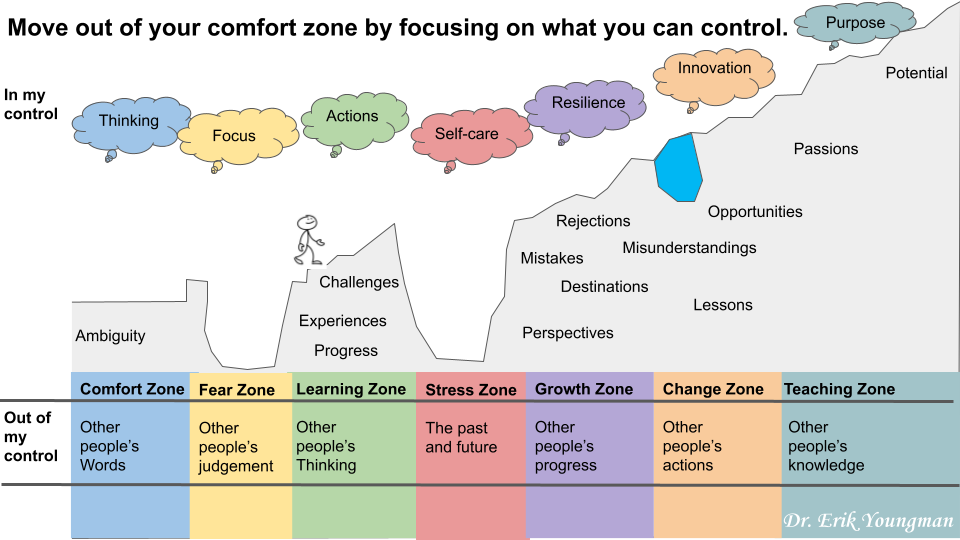
Bloom’s Taxonomy
Bloom’s Taxonomy helps frame conversations about teaching, learning, and questioning. I first learned about Bloom’s Taxonomy in my education classes at Augustana College with Dr. Randy Hengst. I used them while teaching and being a principal, and continue to read about the taxonomy in articles and on Twitter. Charts and diagrams help educators understand different levels of Bloom’s Taxonomy.
Bloom’s Taxonomy includes an updated version with six levels of cognitive learning: remember, understand, apply, analyze, evaluate, and create. I changed “remember” to “explain” and added a level for “adapt.” Verbs from the Revised Bloom’s Taxonomy were used to guide the new proposed framework explored in this blog.
Noted below is the third guiding image that includes information about what a person can control, different processes and journeys, what can’t be controlled, and Bloom’s Taxonomy.
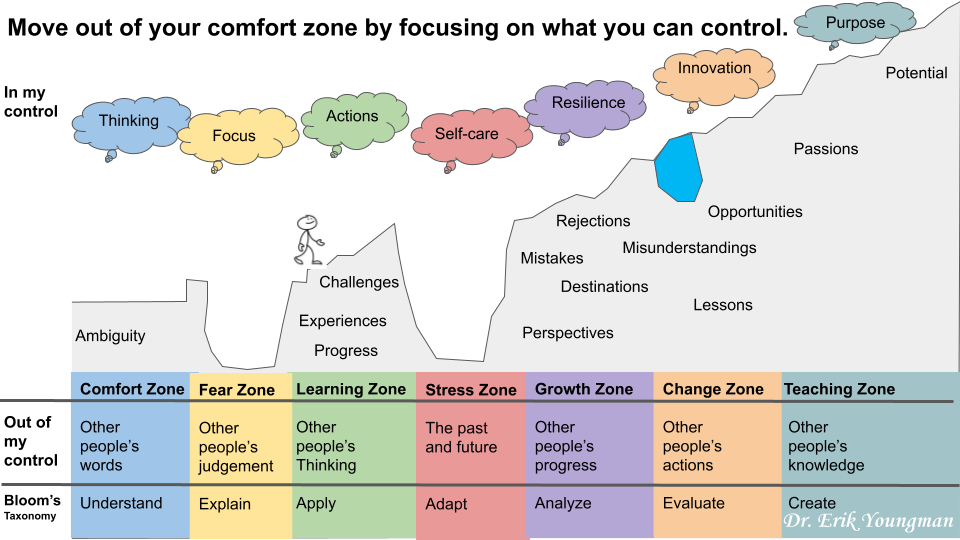
Levers
Levers of getting started, seeking help, self-care, and the strategy toolbox are the final topics in the proposed framework. All of these levers can be used before, during, or after areas of focus in some capacity. Timing and type of use can have positive and negative impacts on outcomes.
Starting
Starting is difficult, but it is the first step in everything. There is a mental load when procrastinating causing people to be mindful of regrets for not starting yet. You don’t need to figure everything out before taking the first step. The first step is big and complex. Then it gets easier as you make progress. Work hard in the beginning, learn and enhance clarity while doing, build momentum by pushing yourself, and adapt while doing the best you can.
Before starting, people spend a lot of time thinking what if or regretfully think, “If only I would have started earlier.” Start small, slow, or privately. Just start. Don’t rush or wait. Get to work right away. Starting may be difficult, but the best time to start is now.
Seeking Help
Seeking help includes knowing when and how to ask for help. Understanding who you can seek help from is also important. Extreme or irrational emotions as well as negatively impacted relationships are signs and reasons to seek help.
Self-Care
Self-care is being discussed more than ever. However, people don’t consistently make time for self-care because of major needs and responsibilities with their families and job. Self-care can be deliberately planned to enhance resilience for yourself and others.
Self-care is needed when tired and less focused. Recovery can happen with exercise, journaling, listening to or playing music, cooking, baking, and doing hobbies.
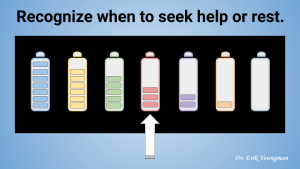
Additional examples include: relax, recharge, refresh, reset, realize, redefine, reconnect, reevaluate, replenish, rededicate, reinvent, realize, reduce, regroup, reunite, refocus, restructure, rewrite, reread, and repeat. Integrate self-care into planning to ensure you have energy throughout the process. This helps with not getting burned out. The image below can help remind parents and educators to help others recognize when and how to seek help and rest.
The Strategy Toolbox
The strategy toolbox includes skills, strategies, and mindsets that can be used at different times. Skills and strategies should be learned and practiced. Then, they can be leveraged when initial attempts are not successful yet. Skills include: asking questions, defining problems, using models, solving problems, constructing arguments, critiquing, reasoning, investigating, interpreting data, constructing explanations, designing solutions, engaging in arguments, evaluating, communicating, self-assessing, synthesizing, making connections, investigating, and exploring.
In addition, innovating, analytical thinking, critical thinking, creativity, social influencing, leadership, technology use, stress tolerance, reasoning, and resilience. General mindsets that focus on gratitude, kindness, and growth mindset can be helpful. The four levers that can enhance the impact of these frameworks are summarized in the table below.
Four Levers
| Lever | Starting | Seeking Support | Strategies | Self-care |
| Related image | Starting line | Phone | Toolbox | Bench |
| When | Before, during, or after | |||
| What | Help, questions, support, advice | Thinking, strategies, tools, and resources | Thinking, stretching, strategies, movement, resources, mindfulness, and gratitude | |
| How | Courage
reflection |
Write, text, use technology, call, ask, and signal | Application, readiness, and practice | Format, form, sequence, options, intensity, and frequency |
Noted below is the completed image of the “Move Out of Your Comfort Zone by Focusing on What You Can Control Framework.” Hopefully, the image, blog, and table empower everyone to patiently appreciate opportunities, interactions, collaboration, adaptations, learning, and growth during every process or journey.
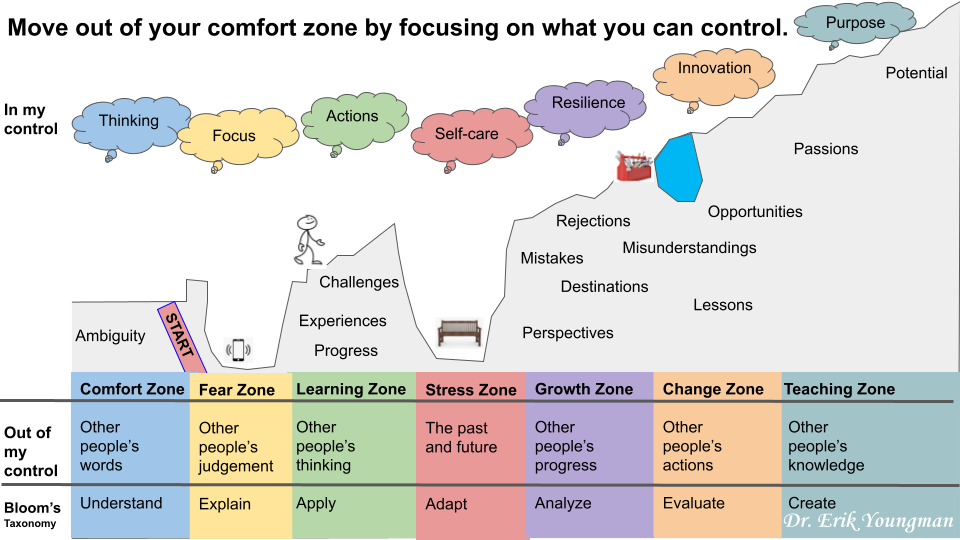
Move Out of Your Comfort Zone by Focusing on What You Can Control Framework
Application of the “Move Out of Your Comfort Zone by Focusing on What You Can Control Framework” can happen by reviewing each zone. Information will be explained in the sequence of processes and journeys, what is in my control, what is out of my control, the Revised Bloom’s Taxonomy, as well as potential levers.
Comfort Zone
The framework begins with the comfort zone. People in their comfort zone are typically complacent, passive, and independent rather than active. For comparison, the learning and growing zone includes behaviors that are more proactive and impactful and result in changes. You might be in your comfort zone when you are safe, satisfied, content, and in control. In the comfort zone, there is minimal urgency, things are status quo, and you feel calm and relaxed.
An applicable process or journey is ambiguity. Thinking can be controlled. Other people’s words can’t be controlled. The applicable Revised Bloom’s Taxonomy verb is understand. The potential lever is getting started.
Benefits of the Comfort Zone
Benefits when in a comfort zone include safety and satisfaction. Negatives to be aware and cautious about include minimal drive or urgency for significant growth and probably limited enhancement of relationships.
Enhance learning and growth when in a comfort zone by finding, identifying, and understanding the reasons and benefits of getting out of your comfort zone. Define ambiguity by understanding components, trends, strategies, and relationships. Rather than settling, get started now to stretch yourself. Take risks to get out of your comfort zone. Then repeat the process to enhance progress and your confidence.
Fear Zone
You might be in your fear zone when you are frightened, unsure, hesitant, lacking confidence, or don’t understand adequate information. Reactions include not acting fast enough, not participating, avoiding, and making excuses.
Focus can be controlled. Other people’s judgments, opinions, and reactions can’t be controlled. The applicable Revised Bloom’s Taxonomy verb is explain. The potential lever is seeking help.
Benefits of the Fear Zone
Benefits when in a fear zone include pausing to gather information and make adjustments. In addition, finding opportunities to seek help and learn information and perspectives from someone else. Negatives to be aware and cautious about include not making progress and acting in unexpected ways. In addition, dissatisfaction regarding alignment with independent or group expectations, and negative consequences or ramifications for not finishing a task.
Focus on a vision and present actions that you can control rather than insecurities, worries, and fears. Enhance learning and growth when in a fear zone by focusing on what can be controlled. An example is what you pay attention to and give energy to and how you spend your time. Confidence, beliefs, self-talk, valuing different perspectives, and a growth mindset can enhance dealing with what can’t be controlled. Explain your thoughts and feelings to others while seeking help and improving. Finally, ensure your reactions don’t escalate negative outcomes or enhance urgency when not needed.
Learning Zone
You might be in your learning zone when dealing with challenges, acquiring skills, exploring, taking responsibility for actions, and creating an environment that limits distractions. The learning zone and growth zone are similar. However, the growth zone is more focused on primary targets rather than more general like initial learning.
The learning zone can be guided by another framework, Maslow’s hierarchy of needs. Maslow focused on the desire to be the best you can be, esteem, love and belonging, safety, and psychological needs.
An applicable process or journey is challenges, experiences, and progress. Actions can be controlled. Other people’s thinking can’t be controlled. The applicable Revised Bloom’s Taxonomy verb is apply. Apply previous learning and make connections to different situations.
Benefits of the Learning Zone
Benefits when in a learning zone include embracing, learning, and making progress with challenges and experiences. Negatives to be aware and cautious about include being hyper-focused on a task rather than looking at the larger picture or empathetically thinking of others.
Beliefs, self-esteem, and belonging can enhance dealing with what is in our control. For actions, take new challenges, be vulnerable, and scrutinize what you respond to and what you say. Embrace the present time, interactions, moments, journeys, progress, and the learning process. Learn information to make informed decisions, appreciate new perspectives, and develop habits and routines.
Stress Zone
You might be in your stress zone when you are unsure of what to do next, encounter high expectations, have too much to do, or have a deadline to meet. When feeling like you are in the stress zone evaluate the size of problems or challenges. Decide what to focus on, and evaluate your sense of security on a spectrum. Imagine a peaceful solution. Focus on your breathing. Practice mindfulness to become more aware of fear.
Face fears and visualize positive outcomes. Reflect on potential meaning and sense of purpose. Talk with others, get support, or go for a walk or run outside to reduce stress and calm down. Enhance self-compassion by treating yourself like you treat friends. Run towards your fear to learn more about situations to demystify fear. Beliefs can enhance dealing with what can and can’t be controlled. For self-care, reflect on how you feel, boundaries, kindness, gratitude, and grace.
Self-care can be controlled. The past, future, and outcomes can’t be controlled. There is not an applicable Revised Bloom’s Taxonomy verb, rather a new verb, adapt, was added. The potential lever is self-care which leverages thinking, stretching, strategies, movement, resources, mindfulness, and gratitude by modifying format, form, sequence, options, intensity, and frequency.
Benefits of the Stress Zone
Benefits when in a stress zone include an opportunity to regroup, focus, or perform better than expected. Negatives to be aware and cautious about include extreme stress, embarrassment, decreased performance and confidence, and not isolating from help or friends. Enhance learning and growth when in a stress zone by focusing on current self-care and adapting to new information and options. Adapt thinking, planning, and actions; reflecting, and evolving.
[scroll down to keep reading]Growth Zone
You might be in your growth zone when you exert effort to set goals, accomplish objectives, clarify purpose, or chase dreams. Growing equals targeted and committed application of learned skills and strategies.
Applicable processes or journeys include rejections, mistakes, destinations, misunderstandings, perspectives, lessons, and opportunities. Resilience can be controlled. Other people’s progress can’t be controlled. The applicable Revised Bloom’s Taxonomy verb is analyze. The potential lever is the strategy toolbox. Tools in the strategy toolbox include thinking, strategies, tools, and resources that can be leveraged by application, readiness, and practice.
Benefits of the Growth Zone
Benefits when in a growth zone include targeted independent or group progress. Negatives to be aware and cautious about include other people’s progress and outside evaluations regarding the speed of progress.
Enhance learning and growth when in growth by analyzing options, perspectives, and questions while embracing learning from adversity. Empower reflection and writing to enhance prioritization, clarity, purpose, and mission. Become obsessed with goals. Don’t stop until you are done.
Build systems that guide progress in the correct direction. Celebrate small victories, progress, and strengthened relationships. Overcome challenges and pain while becoming the best version of yourself. Maybe most importantly, remember to focus on being better each day rather than comparing your progress to other people’s progress or expectations.
Recognize the importance of actions that are ultimately more important than goals. Explicitly teach about growth mindset, mindfulness, and individual and team progress. Provide instruction on being teachable and embracing and learning from mistakes, challenges, and ambiguity. Seek to understand fear and anxiousness and how to calm down while gathering information, and evaluating options.
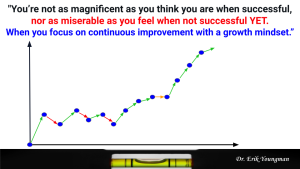
Create a routine that includes identifying a task and working uninterrupted for a specified duration that includes scheduled five-minute movement breaks. Continuously identify, balance, and discuss three to five priorities that empower personal, group, and family growth.
Multiple priorities in different areas of life allow for more balanced focus, discussion, and emotional reactions. You’re not as magnificent as you think you are when successful, nor as miserable as you feel when not successful YET. When you focus on continuous improvement with a growth mindset.
Change Zone
You might be in your change zone when you see a need to change, are told to change, or recognize potential reasons to consider changing. Evaluate, trust, and value the change process. Be aware of why and how the change will occur.
Applicable processes or journeys include passions and potential. Innovation can be controlled. Other people’s actions can’t be controlled. The applicable Revised Bloom’s Taxonomy verb is evaluate. The potential lever is the strategy toolbox. Tools in the strategy toolbox include thinking, strategies, tools, and resources that can be leveraged by application, readiness, and practice.
Benefits of the Change Zone
Benefits when in a change zone include an opportunity to improve, start over, or completely change. Negatives to be aware and cautious about include reluctance for change, not understanding reasons for change, and not creating an urgency for change.
Enhance learning and growth when in a change zone by focusing on and evaluating passions, potential innovation, and continuous improvement. Beliefs can enhance dealing with what is in our control. For the change zone, focus on what I am passionate about, what I hope to change, and what sacrifices might need to be made. Reflect on the potential positives and negatives associated with the short- or long-term change.
Teaching Zone
You might be in your teaching zone when you understand information that you can model, share with, or teach others. Hopefully, you are motivated by a bigger picture guided by gratitude, kindness, and hope that helps inspire and empower others. When in the teaching zone, explain what you are teaching and why it is important. Simplify and break teaching and learning into reasonable chunks. Provide feedback in a variety of ways throughout the process.
Processes and journeys that guide the teaching zone are potential and passions. Realize the potential of yourself and others and connect to meaningful passions for yourself and others. Purpose can be controlled. Other people’s knowledge can’t be controlled. The applicable Revised Bloom’s Taxonomy verb is create.
Benefits of the Teaching Zone
Benefits when in a teaching zone include enhancing collaborative commitment or curiosity. Negatives to be aware and cautious about include learners not being ready or interested in learning something yet.
Enhance learning and growth when in a teaching zone by connecting with learners’ needs, abilities, interests, or passions. Teaching equals simplifying, empowering, supporting, and creating opportunities. Beliefs can enhance dealing with what is in our control. For the teaching zone, focus on helping others, other people’s success, and team success.
Summary
The next time you think of telling yourself or someone else to focus on what you can control or to get out of your comfort zone, think about what you read in this framework. Hopefully, your self-talk or recommendation becomes more specific and empowering.
This isn’t a guiding framework yet. Rather this is an iteration of a framework to guide additional reflection and discussion. Use the framework, blog, and images to empower others out of their comfort zones and recognize different zones they can plan for. This framework continues infinitely. Continue making and appreciating progress while applying learning to complete more complex tasks while empowering others. Inspire yourself and others to enhance focus and drive to curiously learn and teach with a growth mindset.
What additional frameworks or hierarchies could also be connected to comfort zones and focusing on what can be controlled? Please share comments with me via Twitter (@Erik_Youngman) and find additional information about collaboration opportunities via my website (ErikYoungman.com).
About Erik Youngman
Erik Youngman is an education leader who is passionate about topics such as homework, grading, leadership, and growth mindset. He recently completed his nineteenth year in educational leadership. Erik is the Director of Curriculum, Instruction, and Assessment for Libertyville District 70 in Libertyville, Illinois. Previous education experiences include being a principal in Libertyville as well as an assistant principal and teacher in Gurnee, Illinois.
Erik earned a Doctorate in Educational Leadership, an Education Specialist Degree, and a Master of Science in Education from Northern Illinois University and a Bachelor of Arts from Augustana College. Please follow and contact Erik via Twitter: @Erik_Youngman.



